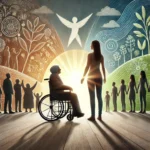“But you look ‘normal’ in your pictures”, was of the kind of messages that I used to receive from the men to whom I disclosed my disability to the men showing interest in my profile on Tinder. What do they mean by the word ‘normal’? My disability instantly made me feel ‘abnormal.’ There came up a symbolic frontier between the ‘normal’ and the ‘deviant,’ and I suddenly lost my identity as a woman and, above all, as a sexual being.
Innumerable terms have been, and are, used to define what is meant by disability as well as persons with disabilities like, ‘handicapped’, ‘abnormal’, ‘spastic’, ‘cripple’, ‘dumb’ and ‘invalid’ etc. Words such as ‘victim, ‘sufferer, and ‘afflicted’ create barriers between disabled and non-disabled people.
We are all aware of the fact that there is a complex and multifaceted relationship between language and sexuality. Language plays a major role in objectification where an individual is reduced to a ‘body’; when a person is treated and identified with their body, or body parts or one is reduced to appearance i.e. the treatment of a person happens primarily in terms of how they look, or how they appear to the senses.
Discourse and language cannot be easily separated as both influence each other. Labels that a language uses tend to stigmatise, and discourses silence. Thus disabled people are silenced in various ways. It leaves them with no language with which to express themselves, their sexualities, their desires and it invalidates their narratives, rendering them completely invisible.
Such blatant objectification determines who is on sexual map or not. And disabled people are by default viewed as nonsexual. Being objectified is toxic. Being objectified hurts our self-image and mental health. Not being socially perceived as sexual beings, disabled women are left out of the sexual objectification faced by our nondisabled peers. They are unable to live up to social and cultural understandings of gender presentation. They are not seen as fully women.
On the other hand, the term ‘able bodied’ is widely used to refer to anyone without an evident impairment. This term creates implicit assumptions about normality, reflecting how society’s attitudes and prejudices enable those without impairments while disabling those with impairments.
In the realm of sexuality and disability, there is a public discourse on deviance and victimization and non-sexuality with a missing discourse of pleasure.
Language is a key resource through which human beings communicate and understand the world. The most significant affordances granted by language are the labels through which individuals and groups create identities—sexual or otherwise—that serve specific purposes. As language is used to discuss issues of race and gender, which is quite significant in addressing discriminatory attitudes and behavior, the same is true for the language of disability since it powerfully impacts how people with disabilities look at themselves and how they are seen by others.
Not only do language labels disabled people, but other parts of the language also inflict negative connotations in more subtle ways. Medical definitions assign disabled people the labels of “patients” and “cases.” There are descriptions such as “afflicted by,” “suffering from,” “stricken with,” and “a victim of”, which infer weakness, lack of agency, martyrdom, and individual responsibility. Also detrimental to the self image and personal identity of disabled people is the use of adjectives as nouns, as in “the deaf,” “the blind,” “the mentally retarded,” “the handicapped,” “the disabled,” “the developmentally disabled” and “the chronically ill”. Some bodies are described by their disabled parts, such as dropped feet, paralyzed limbs, and infected lungs (respiratory issues), and ignore the body/person as a whole.
All of these adjectives used as abstract nouns contribute to the stigmatization process by reinforcing the tendency to “see” persons with disabilities only in terms of those disabilities. These labels not only desexualize but also dehumanize them. They hide an individual’s social identity within a limited category.
The language of ‘vulnerability’ continues to be present throughout the public discourse regarding disabled people. This frame conveys weaknesses, a lack of capacity, and the agency of a person to look after themselves. It is used to demark a group of people who cannot be expected to assume the same responsibilities as others and are not considered as ‘sexual citizens.’ It is employed to invoke sympathy, charity and to secure special ‘protection.’ This language of vulnerability makes disabled people less safe, less independent, and sexually active. For instance, describing a wheelchair user as ‘confined to a wheelchair’, erodes a person’s ability to feel. This hampers the ability to set boundaries around privacy with no control over our lives and stories. As a consequence, they are more vulnerable to “bad sex”—relationships, which are exploitative and disempowering in different ways.
We must not forget that disabled young people are sexual beings and deserve equal rights and opportunities to have control over, choices about, and access to their sexuality, sexual expression, and fulfilling relationships throughout their lives. This is critical for their overall physical, emotional, and social health and well-being. Misconceptions surrounding disabled people being non-normative or deviant suppress their sexual expression.
This creates a vicious circle, thereby causing them to have lower levels of sexual knowledge and inadequate sex education than their non-disabled peers. They are not only unable to learn about sexual rights, sexual identity, and sexual expression, but also about how to ensure their sexual safety.
Language is an important element of breaking down the ‘them/us’ divide between disabled and nondisabled people. It must not relegate a disabled person to a marginalized society. Where possible, language that unites disabled and non-disabled people should be used, while specific language relating to impairment and its effects needs to be used only when it is important to clarify specific situations.
Our ideas about sex and sexuality are bound by the language used to define and discuss them. For language to be liberated, new meanings must emerge and become functional. To stay with the chess analogy, the word must be capable of making new “moves.”



